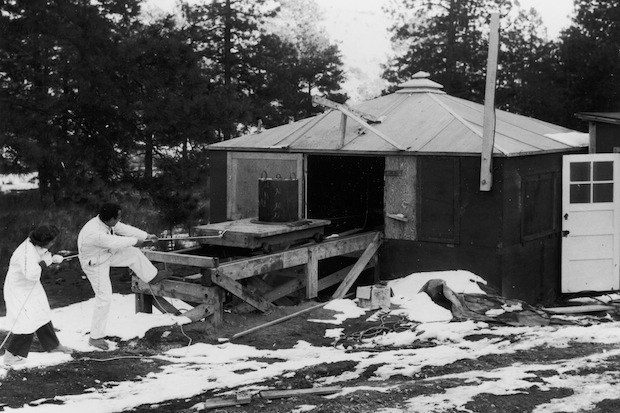At the dark heart of this dark book is a startling fact: Joseph Conrad was employed to steam up the Congo river by the same company, Union Minière du Haut Katanga, that later shipped uranium from the Congo to the US, where it was used to make the bombs that devastated Hiroshima and Nagasaki. Patrick Marnham develops that historical oddity into a brilliant travelogue, blended with an angry history of America’s atomic bomb and a meditation on what the creation of nuclear weapons means for the human psyche. It is his own journey into a Heart of Darkness.
He follows not a river, however, but the flow of uranium. He visits the original Congolese mine at Shinkolobwe (‘the fruit that scalds’), tours the badlands of New Mexico where the bomb was developed and ends in the ironically named ‘Control Zone’ surrounding Fukushima, Japan, which is the nearest landscape he can find to one devastated by a nuclear explosion.
The travel writing is first-class. In Belgium’s monstrously huge Palais de Justice, Marnham describes the colony of blind cats that exists in the subterranean darkness of the legal archives. In the decaying sheds of Kinshasa’s National Museum, he sees ‘wooden figures so beautiful that you wanted to reach out and honour them, beside fetishes, twisted, clotted and black, which you would rather not see at all.’
In the control room of Kinshasa’s decrepit nuclear reactor, he notices that ‘a transparent, plastic ice-cream container has been placed over the button’ that would fire up the reactor. ‘Kinshasa is not so much the capital of a sovereign state’, he comments, with lugubrious savagery, ‘as the abandoned control panel of a long-dead empire.’
Marnham’s thrillingly ominous account of New Mexico introduces a key topic, the destruction of Native American society, and a surprising key character, the classical art historian Aby Warburg. Warburg came to New Mexico in 1895, just after the end of the American Indian Wars, to study the Snake Dance of the Hopi people. They worshipped the rain-giving lightning in the form of a rattlesnake and this worship was, for Warburg, ‘man’s primeval reaction to the universal terror of his existence’. And Hopi territory later became the site of Los Alamos, the site of the Manhattan Project…
If such links feel forced, the observation remains exquisite. In the National Atomic Museum at Albuquerque, the earrings made by Navajo silversmiths in the shape of Little Boy and Fat Man, the bombs dropped on Japan in 1945, ‘were still on sale but kept behind the counter, following complaints from Japanese’. In the New Mexican desert that stretches all around the site of the first atomic bomb test, Marnham sees
the empty grasslands stretching south as far as the eye could see; the black hole at the centre of an imperial explosion, a landscape without life or purpose, a place where idealism ran out of territory.
What pulls all this together, then, is liberal outrage against imperial expansionism and the technology of death. Marnham concludes that the epic myth of the West is ‘the story of one last stand after another until, after 100 years of them, the gallant band of 90 million survivors ran out of savages to be scalped by’ — and thus began US expansion into the Pacific.
Beyond this grim, anti-imperialist reading of history lies a more interesting thesis. Warburg, again, is the odd-shaped key. After suffering a mental breakdown, in 1923, he apparently cured himself by delivering his seminal lecture on the Hopi Indians’ Snake Dance, which compared primitive symbolism with the West’s technological civilisation, which was apparently accelerating towards its own existential destruction. Visiting the Swiss asylum where Warburg was treated, Marnham finds ‘a place where reason and order are easily imposed’. He also finds the clinic’s nuclear shelter:
When the whole world goes mad, those who are officially mad can retreat into this chamber before being allowed to mount the concrete staircase and emerge into the devastated world of sanity above.
The last quarter of the book subsides into an appalled but relatively conventional account of how American physicists, led by Robert Oppenheimer, built the bomb. Marnham confesses that he was going to write a biography of Oppenheimer before being put off by finding him ‘repellent’. It shows.
There is a fine epilogue, however — and it is triggered by a coincidence of timing. Marnham is filming in the southern Congo. (This book is loosely linked to an award-winning documentary of the same name.) He gets access to Shinkolobwe, only to find that illegal miners have completely obliterated the mine: what was sealed off and abandoned as a capped-over hill in 1960 is now a crater, with the mine-shaft’s seal visible within it ‘as a long concrete pillar that has snapped off and tumbled onto its side’.
While they are filming, news comes through from Fukushima. Marnham goes, of course, and blends his travelogue with an account of the hideousness of Hiroshima and Nagasaki. The blasted Japanese heath, you realise, is the ‘heart of an immense darkness’ to which the Congo river ultimately leads. We’re back to Conrad. Marnham is warning us not to be like Warburg or Oppenheimer or Kurtz — not to place ourselves among those survivors of existential trauma who, as he puts it, ‘took refuge from the horrors of reality in the sanctuary of their delusions’.
This brilliant, flawed book has the flavour of a nightmare. It is unsettlingly and sometimes unsatisfactorily bound together, but it haunts the mind with all the long-lived nastiness of decaying radioactivity.






Comments